EDITOR’S NOTE: This is Part Two of a two-part series by Andres Salomon looking at NE 65th Street safety improvements. Part One describes the urgent need for safety improvements along the part of 65th where five people have been killed and seriously injured in the past two years. Part Two looks at possible solutions.
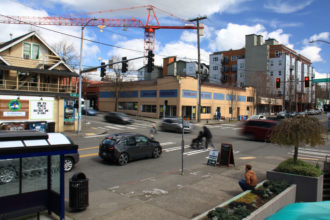
NE 65th Street has proven to be dangerous to people walking, biking and driving. The city urgently needs to make safety improvements, as I’ve outlined in Part One. Not only are any significant safety improvements being delayed until 2019, but the improvements proposed by SDOT do not go far enough.
The NE 65th corridor will see explosive growth in the numbers of people walking, biking, waiting for the bus and taking light rail in coming years. The current proposals from the city short-change people walking, biking, and riding mass transit in order to prioritize the flow of cars. The city needs to do better.
An SDOT survey is live now through June 1, so be sure to fill it out and let the project team know that we urgently need real improvements to NE 65th. You can also contact city officials directly:
- Councilmember Rob Johnson (206) 684-8808
- Councilmember Mike O’Brien (206) 684-8800
- SDOT Director Scott Kubly (206) 386-4143
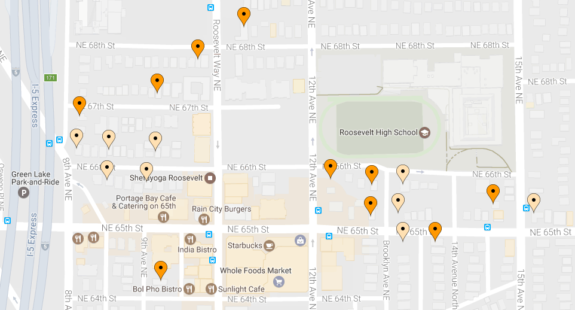
Before diving into roadway designs, let’s first examine what NE 65th St will soon become. Seattle In Progress shows at least 672 new housing units being built adjacent to 65th, with another 1,025 units pending approval. Most of those buildings include retail and few parking spaces, which means that we can expect many more people walking or biking to transit and shopping in the area. In four years, the Roosevelt light rail station will be opening at the corner of 12th Ave NE and NE 65th. There are already so many kids at Roosevelt High School who take public transit every day that they don’t even fit onto the sidewalks at bus stops.
#Fix65th at 15th @RavennaBlog @ravennabryant pic.twitter.com/emWwhxgg1J
— Oralea White (@OraleaW) May 17, 2017
Looking at the roadway itself, NE 65th has what traffic engineers call “excess capacity.” There is more space on the street than needed to move the number of motor vehicles using it. This leads people driving to feel comfortable traveling at speeds faster than they should be going in an urban environment. It also means longer crossing distances for pedestrians and “no room” for bike lanes. As a result, fewer people bike, walk or take transit.
A four-to-three road diet, like the 2013 safety project on NE 75th, right-sizes the roadway to match capacity with the actual number of road users. The result is a street that can still move cars (traffic on NE 75th actually improved after the changes), but does so much more safely.
Here are the long-term proposals put forth by the city for NE 65th:
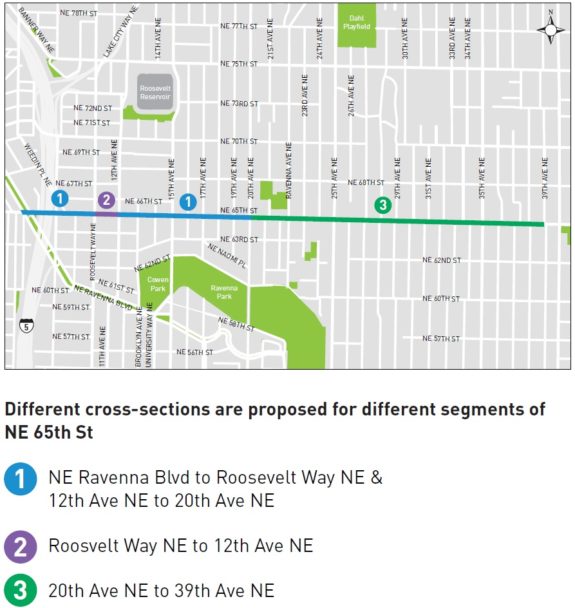
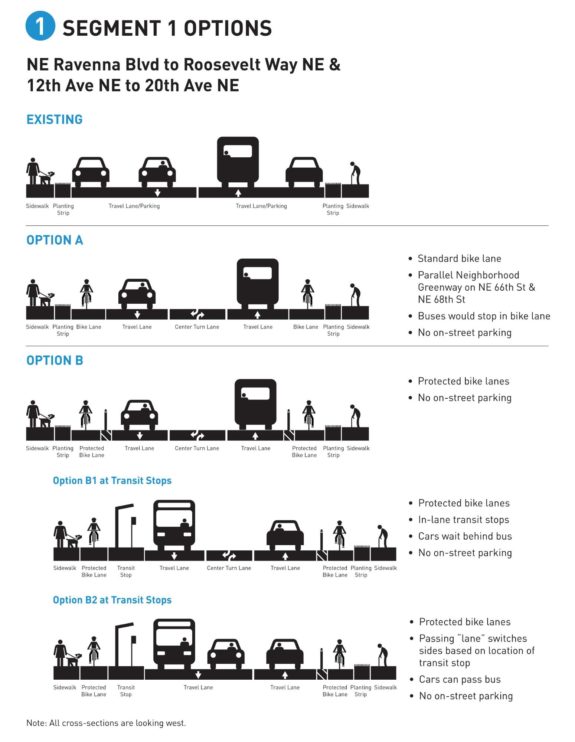
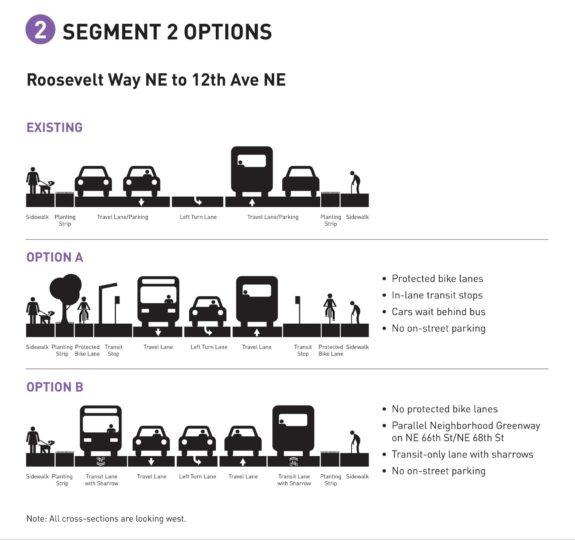
NE 65th already has lots of kids biking on it. The ENTIRE POINT of the community’s #Fix65th demands is to stop people from getting hurt and dying. A protected bike lane between Ravenna Blvd and 20th Ave NE is simply non-negotiable, and it’s a amazing that SDOT even provided a option that does not include one.
Some morning activity on #Fix65th… pic.twitter.com/rWsv6OVSgJ
— Oralea White (@OraleaW) May 15, 2017
@KFMackinnon @ravennabryant @NEGreenways Was just watching some kids bike to school thinking…. what are you thinkin’ @seattledot? pic.twitter.com/J9iIWtKhla
— Oralea White (@OraleaW) May 11, 2017
At the same time, both options include a center turn lane for the whole length. This means that at transit stops, the roadway will actually need to be widened (removing some of the planting strip) to fit the three general-purpose lanes, the bus stop, and the sub-standard, four-foot bike lanes.
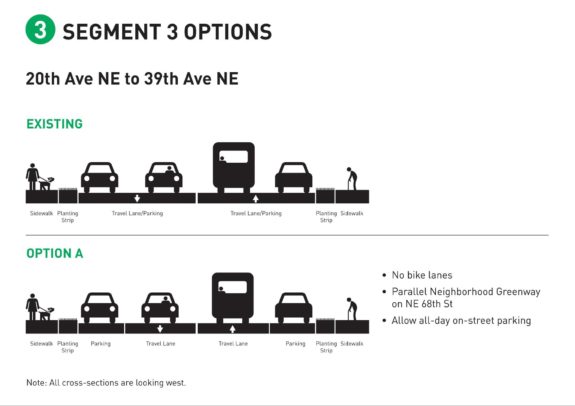
Here’s the icing on the cake: Removal of peak-hour parking restrictions is the only change proposed east of 25th Ave NE. This is a segment of roadway that is dangerous precisely because no one parks on it. Parking counts I conducted along there a few years ago showed entire blocks with one or no cars parked. NE 75th suffered from the same problem (underutilized parking), so we did the sensible thing: We removed the parking. Parking is used in the business district (20th to 25th), but east of 25th (aside from Bryant Corner Cafe) there’s little need for on-street parking.
Bolder options for NE 65th
Outside of the Ravenna business district, NE 65th has far lower traffic volumes than NE 75th. In fact, traffic levels suggest an even bolder safety project could be the best solution for NE 65th. An argument can be made that 65th only needs a center turn lane at major arterial intersections. This would lead to a slower, calmer street that is easier for pedestrians to cross. It would also provide more space for other modes.
The following options are an attempt to achieve what the community has been demanding for years: A slower, safer NE 65th that is easier to cross. Protected bike lanes will not only make it safer for our kids and seniors to bike on 65th, they will also narrow the roadway to slow cars and shorten crossing distances. The bike lanes will also act as a buffer between car traffic and the sidewalk.
Here’s what the City could have proposed (mocked up using StreetMix. UPDATE: You make your own mixes by starting with the existing Segment 1, Segment 2 and Segment 3):
 Segment 1 Option C also allows us to make short-term curb bulb improvements that wouldn’t conflict with these longer-term improvements.
Segment 1 Option C also allows us to make short-term curb bulb improvements that wouldn’t conflict with these longer-term improvements.
- A two-way protected bike lanes on one side of the street
- Parking on the other side of the street (providing a sidewalk buffer)
- No center turn lane
- Flexibility for a bike route transition to the proposed neighborhood greenway on NE 68th St.
 Segment 1 Option D wouldn’t allow short-term curb bulbs, but could be implemented sooner
Segment 1 Option D wouldn’t allow short-term curb bulbs, but could be implemented sooner
- One-way protected bike lanes on both sides of the street
- On-street parking protects one of the bike lanes
- No center turn lane
Any road diet should match our planned capacity for the corridor. Encouraging thousands of new car trips with the addition of a 75th-style center turn lane throughout NE 65th would be a huge detriment to the neighborhood, to businesses, and to the environment. The space that SDOT is proposing to use for a turn lane could instead be used for other purposes. In these examples, we use it for parking.
Sidewalks are not included in these images because the City doesn’t have accurate data on the existing sidewalk widths. However, it is clear that the current sidewalks are uncomfortably narrow and not ADA-compliant in many places. Depending on the budget and future development plans, we should consider widening sidewalks in certain spots instead of retaining parking.

 At bus stops, Segment 1 Option C includes:
At bus stops, Segment 1 Option C includes:
- A two-way protected bike lane
- In-lane bus stops for stops on the same side as the bike lane
- Space for buses to pull out of traffic on opposite side of bike lane
- Flexibility to instead have in-lane bus stops in both directions.
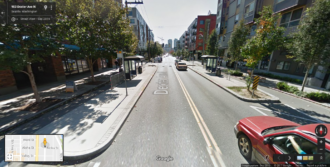
The Segment 1 Option D bus stops look pretty much like Dexter Ave N:
- One-way protected bike lanes on both sides of street
- In-lane bus stops in both directions
- No need to narrow the sidewalk (unlike SDOT’s Segment 1 Option B)
- Bike lanes maintain standard widths
Segment 1 Option D requires in-lane bus stops. With center turn lanes located only at major intersections, the roadway would function much like Dexter Ave N does today. The key differences between what the city proposes and what we’re proposing is that the sidewalks don’t need to be narrowed and the bike lanes don’t have a sub-standard width.
The stretch of NE 65th east of 25th Ave NE is neglected in the current plan, but is ripe for improvement. Here are the options SDOT could have offered:
- Narrow protected bike lanes in both directions
- No center turn lane
- Wider protected bike lane in the uphill direction
- Narrow paint-only bike lane in the downhill direction
- People biking downhill given the option to take the lane or ride slowly in narrow bike lane
Both of these options would be a vast improvement over the current state of 65th and the city’s current proposals. NE 65th is less steep than NE 68th, and it has lots of destinations. People will continue to bike on it whether SDOT makes it safe or not. We can’t just ignore safety for people biking, and the City shouldn’t even be discussing narrowing sidewalks on 65th. We can do better than what SDOT is currently proposing.
These designs are obviously incomplete, as a full design would include safer intersections, plans for the Ravenna business district (20th to 25th Ave NE), bus stop designs, a design for any loading zone or parking needs in front of Bryant Corner Cafe, a transition to the parallel NE 68th Greenway, and so on. But hopefully they will inspire the project team to be more bold about building 65th for the walking, biking and transit-centric future that we know is rapidly approaching for this corridor.
Be sure to fill out the City’s survey to let them know that their changes to 65th don’t go far enough.


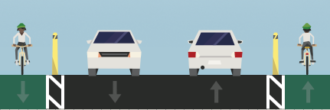








Comments
16 responses to “Salomon: Finally fixing NE 65th Street (Part Two)”
Thanks again, Andres!
Hey, thanks for posting this on your day off! :)
Ok, I’ll chime in. Thank you , Andres.
I like the model of having a wider uphill bike lane (not sure how wide “wider” is) and the option to ride in traffic downhill.
I’ve been riding on Dexter and the new bike lanes on Greenwood. I find the bus island detours on Greenwood are too abrupt so I move out into the traffic lane. (Also, they need to repave many part of it – too many potholes.) So, I support a model which allows flexibility for the cyclist.
As for the completely seperated bikeway, I’ll defer to others. I’ve tried the 2nd ave bikeway but don’t use it. Western uphill and take a traffic lane on 2nd downhill. I’ve also tried broadway, but just a few times. That one works better.
Thanks!
In the interest of clarity, the lane widths were removed from the proposed design pics. The bike lane widths I used for the narrow PBLs (“East of 25th Option B”) design were 5ft bike lanes with a 2ft buffer. The wider PBL (“East of 25th Option C”) is 6ft wide with a 3ft buffer. Those details could be tweaked (maybe the wider PBL should be 7ft wide with 2ft buffer, for example).
Also, I assumed NACTO minimum desired widths for the 2-way PBLs designs (12ft wide with 3ft buffer). That’s actually more spacious than SDOT’s standard, which is 10ft with 2ft or 3ft buffers.
I agree that a continuous bike lane would be nice but could live with the side parking east of 20th. The most important thing is getting rid of the quasi 2 lane setup right now. If the bike lane doesn’t have a concrete barrier I don’t think it is really protected, the little cone things aren’t worth the effort. I also think 2 way bike lanes are a bad idea, it is confusing for everyone involved, especially when the road switches from one on each side.
In the last two years (the first I’ve been biking regularly year round in all weather, lighting conditions and in high traffic areas) I’ve found a world of difference between a paint-only lanes and the plastic post barriers. Paint-only lanes allow (in fact legally require) drivers to enter the bike lane to turn right. This leads to a complex crossing ‘X’ maneuver at most intersections in which drivers move into the bike lane and cyclists sometimes stop but more often shift into the general-purpose lane to pass the turning car. The lack of a default lane to be in for people who are continuing straight through an intersection is exactly the kind of problem that makes 65th so dangerous now (left turning drivers stop in the left lane and drivers continuing straight swerve around into the curb lane). My average speed is a steady 11 miles-per-hour lately (I’m pretty slow even on downhills) so riding in traffic is rarely an option for me on high-traffic streets like 65th.
Paint-only lanes are also often blocked randomly and suddenly by pick-ups, drop-offs and deliveries. While this can and does happen with plastic posts, it’s far less common. When I’m biking in a paint-only lane on this kind of street, I tend to need to look over my shoulder regularly, which takes my attention off the road ahead and affects my control of the bike. With plastic posts, I’m comfortable keeping my eyes ahead. Other benefits of paint-and-plastic are they don’t compromise sight lines around driveways much (I’m not sure how many are on this stretch). They also allow for faster cyclists to use the bike lane but to pass using the general purpose lane if they wish to. The reduction in injury crashes and increase in cycling rates associated with post and plastic infrastructure has been well documented.
I think that something that frequently lost in the discussion of PBLs is that, if you are comfortable biking in traffic, the PBL is not really for you, it’s for others who are not at your level of confidence.
Matt, I generally agree with you. But a quality solution would try to address more than the two extremes: those who will only ride in a PBL and those who are comfortable riding in traffic.
What about those who prefer not to ride in traffic but find the PBL too restrictive – not safe over 10mph, for example, or too crowded.
A good solution would try to find a way to make a PBL usable to a broader range of people. If not, it may be underused and seem like a poor use of public property to drivers.
As an example, the PBL near Westlake comes pretty close to broadly acceptable. The one on 2nd Ave does not – you still have to be very careful of driveways and cars turning left (even though they have a red light).
At the same time, both options include a center turn lane for the whole length. This means that at transit stops, the roadway will actually need to be widened (removing some of the planting strip) to fit the three general-purpose lanes, the bus stop, and the sub-standard, four-foot bike lanes.
Couldn’t you simply not have a turn lane where you have a bus stop? That would be similar to how parking is handled on a street like Dexter (you can’t park next to a bus stop). Except that instead of the bike lane swerving a bit in and out (to deal with the parking and bus stop — https://goo.gl/maps/TyVXoogcdyx) it would be the general purpose lane narrowing, then getting wider after the bus stop. I don’t have a strong preference one way or another (turn lane or parking) but I don’t think a turn lane is that big of a deal. To me that is a community preference thing. Some areas really want their turn lane (to get into their driveway directly) while other areas really want their parking. The choice is a minor issue, in my opinion. The key parts of this are:
1) If you do have parking, bulbs prevent people from using it as a general purpose lane.
2) The bike lane needs to be separated (for segment 1, option B is much better than option A).
3) Cars have to wait behind buses (or buses have their own lane). This can back up traffic, but drivers adjust. They simply use 75th in this case. If you force buses to pull off the main road and then pull back on, the bus becomes much slower.
4) Unless one of the lanes is a bus lane, there should be only one lane heading east and one lane heading west. Two lanes each direction only make sense if you eliminate all turns. It is completely unnecessary in this instance (as mentioned).
5) Ideally, you have more bus priority here. This is about to be a major transit stop; it would be a shame if the buses that could feed it get bogged down. Unfortunately, the only option that even has a bit of this is a mess. Section 2, Option B is it. One block — only one — of bus only lane, operating as a sharrow. While I can understand some of the thought process behind this (being professionals, bus drivers are way less likely to hit a bike than regular drivers) I don’t think most bike riders feel that way. I see little benefit to either group (bus riders or bikes). Meanwhile, if a biker wants to avoid the sharrow, they have to move over to 66th or 68th which doesn’t look very easy. I suppose when they reconnect 66th (across 12th) they could add a traffic light there. That would be decent in the westbound direction (take a right at Brooklyn and bike a few blocks until you can work your way back). But what about heading east? You are cruising along, in a bike lane, then suddenly have the choice of merging with a bus, or trying to go around. Taking a left would mean merging into traffic, so your only choice it to take a right. That sends you down to 64th. But there are no bike lanes there, and adding them would be very difficult, as there is no room: https://goo.gl/maps/oY5nGkBNhXP2. So now you are down to 63rd, which is not a crazy plan, but it needs to be fleshed out. So far, Section 2, Option B is a bad idea. It adds needed bus improvements, but only for one block and at the cost of all of the work to improve bike safety. Either bite the bullet and come up with a plan to send bikes on a parallel set of streets (similar to Madison BRT) or put up with less than ideal bus priority (like on Roosevelt/Eastgate) and a build a very good set of bike lanes.
6) As mentioned, the improvements need to go all the way to 40th, if not Sand Point Way. Super wide streets with parking that is hardly ever uses is a formula for speeding. Add protected bike lanes the whole way and parking as space allows.
An earlier version of this writeup included a reference to Doug Trumm’s 65th RapidRide proposal (https://www.theurbanist.org/2017/01/20/65th-st-rapidride/), and talked more about transit stuff – but this is the bike blog. :)
I’d love to see a transit blog post about 65th. As I mentioned at the end of this post, there’s more design work to be done, but we’re not even there yet. SDOT first has to figure out whether we’re going to prioritize safety, or whether we’re going to prioritize vehicle flow. The 3-lane config doesn’t actually help transit, it just moves more cars and makes left turns nominally safer (fewer fender-benders). However, it’s not left-turning drivers being killed on 65th, it is people walking and biking. That’s where the city should be prioritizing their safety efforts.
>> The 3-lane config doesn’t actually help transit …
It does compared to 2 lanes. With two lanes, cars *and buses* back up behind a car when it turns. Unless you ban left turns (a reasonable proposal) you have more congestion. Without special lanes for the buses, they are stuck in that congestion.
3 lanes seems way safer to to me than 2 lanes plus parking. Parking itself has a couple hazards and an annoyance. You can get hit by a door, or hit by a car moving past the bike lane into an available spot (both are possible on Dexter). Getting hit while a car is trying to park is rare. What is a lot more common is that a car trying to park will force a bike to wait. That isn’t the end of the world (it isn’t dangerous) but on a shallow uphill incline, it is a big pain to lose all your momentum.
But you also have a hazard that is more likely with 3 lanes versus 2 even if you don’t have parking. Imagine someone trying to make a left turn right here — https://goo.gl/maps/UqvytjTbdLn. The driver behind that person might grow impatient, and swerve into the right (bike) lane. There is no physical barrier separating the bike lane (no curb, no posts) but if there were, they would end at crossings (right where a car is most likely to want to turn left).
One of the reasons why Dexter is able to get away with having so few turn lanes is because they have so few turns. There are merging lanes, and side streets, but very very crossing streets. Between Aloha and the Fremont bridge, there is only one (at Crockett). In contrast, 65th is a regular grid most of the way. The scenario I outlined (an impatient driver passing to the right at an intersection) could happen in dozens of places, such as here (https://goo.gl/maps/CcSJWxy96G32).
Having a regular grid does mean you could ban left turns. That would make for a much safer road. That leaves you with an extra lane, and it isn’t clear what you do with it. You could expand the bike lane, add more of a buffer, or make the sidewalk wider. Expanding the sidewalk is the most expensive option (and limits future possibilities). You could also add one lane of parking, but that has a lot of drawbacks from a congestion standpoint. It is also possible that you could add a transit lane one direction. That is an idea worth exploring, but not on this (already long) comment.
In general, I see no problem with the 3 lane concept. Short of banning left turns — something we have been hesitant to do — I think it is the safest thing we can build. Of the options for Segment 1, for example, I think B2 looks the safest and best overall. The problem with the city’s proposal is that they ignored similar treatment to the east, and completely punted on the long term question as to how to balance the biking and transit needs on this street.
As to transit, the two issues are intertwined. Adding bus lanes is one of the key ways to improve transit. This reduces the amount of space available for bike lanes. It is a pretty simple dynamic, with three choices:
1) Give the street bus lanes and put bike lanes on a nearby street (or streets). This is what will happen on Madison.
2) Add bike lanes, and live with fewer bus lanes. This is what will happen on Roosevelt and Eastlake.
3) Add both bike lanes and bus lanes. I don’t think there are any plans for this, as most of our streets simply aren’t wide enough.
Personally, I think the city has done a good job so far. Madison is a very important street from a transit perspective and less so for biking. There are alternatives for biking and they will be used. In contrast, Roosevelt and Eastlake are critical from a biking perspective. We will soon have a protected route all the way around Lake Union, one of the few areas of the city that is reasonably flat. That will connect to extensions in various directions, enabling thousands of people to get around the city in a reasonably safe and pleasant way.
For 65th, I see three choices:
1) Add bus lanes but no bike lanes. The particulars get tricky (running the bus in the left lane, banning left turns, etc.) and no one has actually addressed it. There are articles like Doug Trumm’s that suggest a nice east-west line, but no one has actually tried to map out where bus lanes would be added.
In any event, the key thing I wanted to mention is that if you have bus lanes but no bike lanes, then you need bike lanes on *both* sides of the street. It is too difficult to work you way back and forth. So bike lanes on 68th and 63rd would be necessary (along with added traffic lights).
2) Add bike lanes and no bus lanes. There is some congestion here, but it is nothing like that found on 45th. It is possible that we can simply live with the traffic.
3) Add bike lanes and a small amount of bus lanes. I don’t think it is possible to have bus lanes both directions and bike lanes. You might be able to get away with bus lanes one direction, if you eliminate a turn lane. For example, east of 15th, a bus lane heading west (towards the traffic) is a lot more important than one heading east (towards mostly single family homes). You could eliminate the turn lane for a while and add a bus lane. The particulars of such an arrangement get very complicated and would require studying.
>>It does compared to 2 lanes.
You make the assumption that traffic volumes will stay the same. They won’t- given the capacity, they will increase. Or, if we cap capacity at its current levels and actually provide real alternatives, volumes may decrease (https://twitter.com/NEGreenways/status/408129262470692865 is from local survey; how many drivers would walk or bike those 10 blocks if the road didn’t suck?). The question I’m asking is whether transit will flow better with 2 lanes and less SOV traffic, or 3 lanes with more SOV traffic. I’m arguing that it will flow better with 2 lanes and less SOV traffic. Examples of this include 15th Ave vs University Way.
>> You can get hit by a door, or hit by a car moving past the bike lane into an available spot (both are possible on Dexter).
>> Imagine someone trying to make a left turn right here — https://goo.gl/maps/UqvytjTbdLn.
I compared the proposed design to Dexter because it has similar traffic volumes, and the bus islands/in-lane stops are similar. However, the design does not look like Dexter for the rest of it. Dexter has an unprotected door-zone bike lane, which is.. not good enough. Your “driving into the bike lane” scenario shouldn’t happen because the bike lane would be physically protected, ideally including tightened corners for turns. Getting doored shouldn’t happen because there’s a proper buffer. Bikes won’t wait behind parking cars because there’s a separate lane. A parking-protected bike lane looks like this:
https://1p40p3gwj70rhpc423s8rzjaz-wpengine.netdna-ssl.com/wp-content/uploads/2015/10/IMG_3135.jpg
The real risks are from right and left-hooks, just like with any protected bike lane. This is something SDOT could address, and we’ve been pushing them to, but they haven’t bothered so far.
>> One of the reasons why Dexter is able to get away with having so few turn lanes is because they have so few turns.
The number of turns or grid pattern has little to do with how well this would function; the number of drivers actually making turns is what matters. Dexter lots of left turns, it’s just that the streets they lead to are dead-ends so not many people are turning. I don’t have the turning counts for 65th, but SDOT probably does. They have modeling software that can show the driver (and transit) delays caused by drivers waiting to turn left. That’s why I would rather see left turn lanes ONLY at busy intersections where people are actually turning left.
>> For 65th, I see three choices: 1) Add bus lanes but no bike lanes.
This is a non-starter. Unless you remove driving lanes, we’re talking about 42 feet of roadway width (2 11 foot bus lanes, 2 10 foot general purpose lanes). Fixing 65th does not mean optimizing for transit at the cost of pedestrian safety. The main goal here is to stop people from dying on 65th.
>> So bike lanes on 68th and 63rd would be necessary
I would still bike on 65th (though I often take the too-narrow sidewalk). 65th is less steep, and it’s where the businesses I’m trying to get to are located. This is true for many other people. Anything that doesn’t include bike lanes on 65th is going to result in more people on bikes dying.
Are you sure the actions described are compatible: removing parking, a protected bike lane, and bus stops? On Dexter Avenue North and Roosevelt Way NE, SDOT alternates bus islands and parallel parking to protect the bike lane. NE 65th Street is more narrow than either Dexter or Roosevelt. How would buses reach the curb to pick up intending riders?
Yes. Dexter is 54 feet. 65th is 44 feet. Dexter has parking on both sides, and transit stops are not offset. The 65th designs have parking only on one side, and transit stops would be offset. 44 feet is plenty of space for 2 travel lanes (11 feet each), 2 bike lanes (6 feet each; the one next to a transit stop narrowed to 5 feet), bike lane protection (3 or 6 feet, depending upon whether we’re looking at a 2-way PBL or not), and your choice of a parallel parking lane (7 feet) or a bus island (8 feet).
so, your suggestion is a two-way cycle track, 12; two travel lanes 11+11; bus islands and parking, 8; then: 12+2+11+11+8 = 44??? no left turn lane. bus stops need not be offset. the bus islands and parking should be on the north or inbound side, as there will be more intending passengers.